The Beastiary
Water Dwellers
Terminology
Baleen Whale
A type of whale found in the arctic north. The Karl whale falls under the category of a baleen whale. Baleen refers to the physical structure of the whale; specifically the whale bone. This definition is supported with the following:
"Any of several usually large whales of the sub-order Mysticeti, such as the right whale, having a cylindrical skull, two blowholes and whalebone plates instead of teeth." — American Heritage College Dictionary, Third Edition ©2001
Etymology:Middle English baleine whale, baleen, from Old French, from Latin balaena whale;
"A horny substance growing in the mouth of whales of the suborder Mysticeti that is especially developed in the right whale and grows in dependent plates from 2 to 12 feet long attached in 2 ranks along the upper jaw forming a fringelike sieve to collect and retain food; called also whalebone." — Merriam-Webster Dictionary ©2006
The Humpback Whale of Earth is a baleen-type whale.
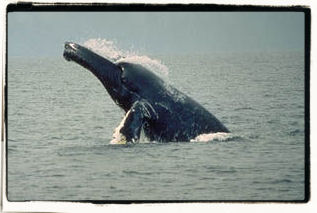
| 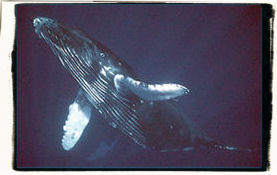 The many faces of the Humpback Whale The many faces of the Humpback Whale |
"Sometimes they managed to secure the… less common Karl whale, which was a four-fluked, baleen whale." — Beasts of Gor, page 36.
"…he removed several strips of supple baleen, whale bone, taken from the baleen whale, the bluish blunt fin…" — Beasts of Gor, page 334.
Gurdo
Not a creature, but rather it is the layered, ventral membrane which is shielded by porous plating, which is common amongst many of the marine predators of Gor.
"… gurdo, the layered, ventral membrane, shielded by porous plating, of several of the marine predators" — Nomads of Gor, page 205.
The Beasts of the Waterways
Bint
A fanged, carnivorous marsh eel which inhabits the rivers of the rainforests inland of Schendi.
"… the bint, a fanged, carnivorous marsh eel…" — Explorers of Gor, page 267.
Cosian Song Fish
Also: Cosian Wing Fish
Native to Thassa, this tiny blue fish, with poisonous spines on its dorsal fins, is capable of projecting itself from the water, hurling it for short distances, thus giving the appearance of wings. The liver of this fish is considered a delicacy amongst Turians. It is sometimes called the Cosian song fish because of the whistling sound it makes when mating. The blue four-spined variety of this fish is found in the waters off of the island of Cos, while larger versions may be found farther out to sea.
"They spend much of the day in the water and, it is said, are more at ease in that element than the Cosian song fish." — Assassin of Gor, page 161.
"Now this," Saphrar the merchant was telling me, "is the braised liver of the blue, four-spired Cosian wingfish." This fish is a tiny, delicate fish, blue, about the size of a tarn disk when curled in one's hand; it has three or four slender spines in its dorsal fin, which are poisonous; it is capable of hurling itself from the water and, for brief distances, on its stiff pectoral fins, gliding through the air, usually to evade the smaller sea-tharlarions, which seem to be immune to the poison of the spines. This fish is also sometimes referred to as the songfish because, as a portion of its courtship rituals, the males and females thrust their heads from the water and utter a sort of whistling sound. The blue, four-spired wingfish is found only in the waters of Cos. Larger varieties are found farther out to sea. The small blue fish is regarded as a great delicacy, and its liver as the delicacy of delicacies. — Nomads of Gor, pages 84-85.
"It is also called a songfish, because, in their courtship rituals, males and females thrust their heads from the water, uttering a kind of whistle." — Raiders of Gor, page 139.
"Cos is also a lofty island, even loftier than Tyros, but she has level fields to her west. Cos had many terraces, on which the Ta grapes are grown. Near her, on night, lying off her shore, silently, I heard the mating whistles of the tiny, lovely Cosian wingfish. This is a small, delicate fish; it has three or four slender spines in its dorsal fin, which are poisonous. It is called the wingfish because it can, on its stiff pectoral fins, for short distances, glide through the air, usually in an attempt to flee small sea tharlarion, who are immune to the poison of the spines. It is also called a songfish, because, in their courtship rituals, males and females thrust their heads from the water, uttering a kind of whistle. Their livers are regarded as a delicacy. I recalled I had once tried one, but had not cared for it, at a banquet in Turia, in the house of a man named Saphrar, who had been a merchant.. Saphrar, I recalled, had once been a perfumer from Tyros but, being exiled as a thief, had made his way to Port Kar, and thence had gone to Turia. I had learned on the rail of the light galley, and, in [-page 139-] the moonlight, had listened to the mating whistles of the small fish. They seemed so small, and innocent." — Raiders of Gor, pages 139-140.
Cuttlefish
Mollusks which are the basic food of the whales.
"Any of various squidlike cephalopod marine mollusks of the genus Sepia, having a calcareous internal shell." — American Heritage College Dictionary, Third Edition ©2001
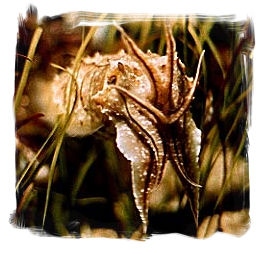
| 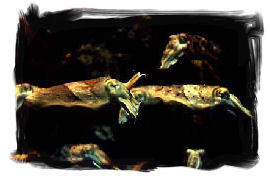 Shown here are different varieties of cuttlefish. Shown here are different varieties of cuttlefish. Below: Sepia Cuttlefish. |
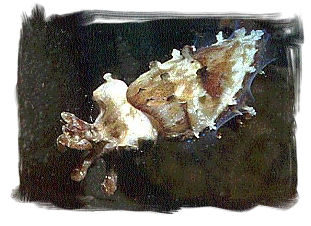
| 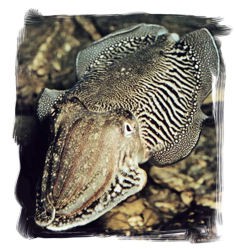
|
"That scent, I knew, a distillation of a hundred flowers, nurtured like a priceless wine, was a secret guarded by the perfumers of Ar. It contained as well the separated oil of the Thentis needle tree; an extract from the glands of the Cartius river urt; and a preparation formed from a disease calculus scraped from the intestines of the rare Hunjer Long Whale, the result of the inadequate digestion of cuttlefish. Fortunately, too, this calculus is sometimes found free in the sea, expelled with feces. It took more than a year to distill, age, blend and bond the ingredients." — Marauders of Gor, page 114.
Eel
A long, snake-like fish of many varieties, 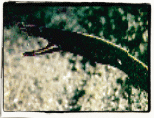 such as the river eel, the black eel, and the spotted eel. The Dock Eel is a black fish, approximately four to seven feet (4'-7') long and weighs about eight to ten (8-10) pounds; carnivorous; they inhabit the shallow waters around the dock and wharves of river ports. The Marsh Eel is a dangerous, carnivorous variety found in the Vosk delta. Eels are a favored catch of fishermen; eaten as a delicacy.
such as the river eel, the black eel, and the spotted eel. The Dock Eel is a black fish, approximately four to seven feet (4'-7') long and weighs about eight to ten (8-10) pounds; carnivorous; they inhabit the shallow waters around the dock and wharves of river ports. The Marsh Eel is a dangerous, carnivorous variety found in the Vosk delta. Eels are a favored catch of fishermen; eaten as a delicacy.
"Not only must they fear the march sharks and the carnivorous eels which frequent the lower delta, not to mention the various species of aggressive water tharlarion and the winged, monstrous, hissing, predatory UI, but they must fear, perhaps most of all, men, and of these, most of all, the men of Port Kar." — Raiders of Gor, page 8 .
"He struck out toward the shore, then clambered toward it, getting his feet under
width="163" height="126" alt="Eel" him. He screamed twice more. When he stood in about a foot of water, among pilings, near the next wharf, he struck down madly at his legs with his left hand, striking two dock eels from his calf. Then, painfully, he moved himself up the sand, staggering, holding his legs widely apart." — Rogue of Gor, page 154.
"The leg seemed gouged. The dock eels, black, about four feet long, are tenacious creatures. They had not relinquished their hold on the flesh in their jaws when they had been forcibly struck away from the leg, back into the water." — Rogue of Gor, page 155."A pirate running for the ship missed the bow rail and fell into the water. He began to thrash and scream in the water, attacked by eels. I looked down, into the water. Freshwater Moray EelBelow me the water was swarming with eels. The blood from my back, I realized, running down the blade and dripping into the water, had attracted them. … Then something wet and heavy, slithering, leapt upward out of the water, and splashed back. My leg felt stinging. It had not been able to fasten its jaws on me. I looked downward. Two or more heads, tapering, menacing, solid, were emerged from the water, looking up at me. Then, streaking from under the water, suddenly breaking its surface, another body, some four feet in length, about eight or ten pounds in weight, leapt upward. I felt the jaws snap and scratch against the shearing blade. Then it fell twisting back in the water. It was the blood which excited them. … If we could get to the free water I did not think the eels would pursue us far from the wharves and shore. … I knew that the fastening of those jaws, in a fair bite, could gouge ounces of flesh from a man's body. Too I knew that the eel seldom takes its food out of the water, that such strikes, in all probability, had not been selected for. … Then almost too quickly to
be fully aware of it, I saw the returning shape erupting from the water. I thrust, as I could, my ankle towards it. Then I screamed in pain. The weight, thrashing and tearing, must have been some fifteen or twenty pounds. It was some seven feet in length. I threw my had back, crying out. My left ankle was clasped in the clenched jaws, with those teeth like nails." — Guardsman of Gor, pages 129-132.
"A man walked by carrying a long pole, from which dangled dozens of the eels of Cos." — Siave Girl of Gor, page 343.
"Many estates, particularly country estates have pools in which fish are kept. Some of these pools contain voracious eels, of various sorts, river eels, black eels, the spotted eel, and such, which are Gorean delicacies. Needless to say a bound slave cast into such a pool, would be eaten alive." — Magicians of Gor, page 428.
Gint
A small freshwater fish which inhabits the rivers of the rainforests inland of Schendi; it has bulbous eyes and flipper-like fins; is amphibious, having both lungs and gills; is capable of walking on its pectoral fins; is often found in the company of tharlarion, feeding off the scraps of their kills. Also known as "Lung Fish."
"I was interested in the fauna of the river and the rain forest. I recalled, sunning themselves on exposed roots near the river, tiny fish. They were bulbous eyed and about six inches long, with tiny flipperlike lateral fins. They had both lungs and gills. Their capacity to leave the water, in certain small streams, during dry seasons, enables them to seek other streams, still flowing, or pools. This property also, of course, makes it possible for them to elude marine predators and, on the land, to return to the water in case of danger. Normally they remain quite close to the water. Sometimes they even sun themselves on the backs of resting or napping tharlarion. Should the tharlarion submerge the tiny fish often submerges with it, staying close to it, but away from its jaws. Its proximity to the tharlarion affords it, interestingly, an effective protection against most of its natural predators, in particular the black eel, which will not approach the sinuous reptiles. Similarly the tiny fish can thrive on the scraps from the ravaging jaws of the feeding tharlarion. They will even drive one another away from their local tharlarion, fighting in contests of intraspecific aggression, over the plated territory of the monster's back. The remora fish and the shark have what seem to be, in some respects, a similar relationship. These tiny fish, incidentally, are called gints." — Explorers of Gor, pages 299-300.
The Giant Gint is a large cousin of the small fish, and is found in western Gor, similar in appearance, but with a 4-spined dorsal fin; is also amphibious and capable of walking on its pectoral fins.
"The creature which had surfaced near us, perhaps ten feet in length, and a thousand pounds in weight, was scaled and had large, bulging eyes. It had gills, but it, too, gulped air, as it had regarded us. It was similar to the tiny lung fish I had seen earlier on the river, those little creatures clinging to the half-submerged roots of shore trees, and, as often as not, sunning themselves on the backs of tharlarion, those tiny fish called gints. Its pectoral fins were large and fleshy." — Explorers of Gor, page 384.
"At the far end of the lagoon, where its channel leads to the river, I saw what had alarmed the girl. It was a large fish. Its glistening back and dorsal fin were half out of the water, where it slithered over the sill of the channel and into the lagoon. I saw the large fish, one of the bulging-eyed fish we had seen earlier, a gigantic gint, or like a gigantic gint, it now having slipped over the channel's sill, disappear under the water. Then she screamed wildly. The fish, on its stout, fleshy pectoral fins, was following her out of the water. She turned about and fled screaming into the jungle. With the butt of the spear I pushed against its snout. The bulging eyes regarded me. The large mouth now gulped air. It then, clumsily, climbed onto the bank. I stepped back and it, on its pectoral fins, and lifting itself, too, by its heavy tail, clambered out of the water and approached me. I pushed against its snout again with the butt of the spear. It snapped at the spear. Its bulging eyes regarded me. I stepped back. It lunged forward, snapping. I fended it away. I then retreated backward, into the trees. It followed me to the line of trees, and then stopped. I did not think it would wish to go too far from the water. After a moment or so it began to back away. Then, tail first, it slid back into the water of the lagoon. I went to the water's edge. There I saw it beneath the surface, its gills opening and closing. Then it turned about and, with a slow movement of its tail, moved away. Ayari and Kisu referred to such fish as gints. I accepted their judgment on the matter. They are not to be confused, however, that is certain, with their tiny brethren of the west." — Explorers of Gor, page 389.
Gorean Pike
A small river fish, carnivorous and piranha-like. Much smaller and different than the Earth pike, which is a gamefish.
"A freshwater game and food fish of the Northern Hemisphere that has a long snouth and attains a length of over 1.2 meters (4 feet); any of various similar or related fishes." — American Heritage College Dictionary, Third Edition ©2001
"Any of several voracious freshwater fishes, family Esocidae, caught both commercially and for sport. They are recognized by the elongate body, small scales, long head, shovellike snout, and large mouth armed with strong teeth. The dorsal and anal fins are far back on the tail. The northern pike of North America, Europe, and northern Asia has pale, bean-shaped spots on the body and lacks scales on the lower parts of the gill covers. It is a fairly common and prized game fish with a maximum size and weight of about 1.4 metres (4.5 feet) and 21 kilograms (46 pounds). The muskellunge and pickerel (qq.v.) are North American pikes similar in habit to the northern pike.
Solitary hunters, pikes, pickerel, and muskellunge lie motionless in the water or lurk in a clump of weeds. As the prey comes within reach, they make a sudden rapid lunge and seize it. They usually eat small fishes, insects, and aquatic invertebrates, but larger forms also take waterfowl and small mammals. They spawn in weedy shallows from late winter through spring.
Pikes are of the order Salmoniformes. Wall-eyed pikes are not true pikes; they are members of the perch order (Perciformes). — Encyclopaedia Britannica ©2006.
"If it were a school of fifteen-inch Gorean pike, for example, I might kill dozens and yet die half eaten within minutes." — Nomads of Gor, page 206.
Gorean Shark
The nine-gilled, 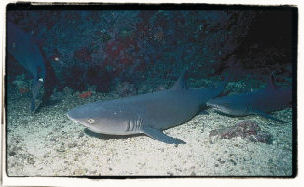 carnivorous shark Gor; there are many varieties of sharks (i.e., river sharks, marsh sharks, salt sharks).
carnivorous shark Gor; there are many varieties of sharks (i.e., river sharks, marsh sharks, salt sharks).
"… Gorean sharks, probably descendants of Earth sharks placed experimentally in Thassa millennia ago by Priest-Kings." — Nomads of Gor, page 205.
"Upon occasion, and it had happened early in Se'Kara this year, the arena is flooded and a sea fight is staged, the waters for the occasion being filled with a variety of unpleasant sea life, water tharlarion, Vosk turtles, and the nine gilled Gorean shark, the latter brought in tanks on river barges up the Vosk, to be then transported in tanks on wagons across the margin of desolation to Ar for the event." — Assassin of Gor, page 190.
"Rising from under the grunt swiftly was a long-bodied shark, white, nine-gilled. It tore the grunt from the line and bore it away. Other dorsal fins, of smaller sharks, trailed it, waiting. Sharks, and sometimes marine saurians, sometimes trail the ships, to secure discarded garbage and rob the lines of the fishermen. — Siave Girl of Gor, page 360.
The Marsh Shark is a large carnivorous fish that lives in the marshes of the Vosk delta.
"Not only must they fear the marsh sharks and the carnivorous eels which frequent the lower delta, not to mention the various species of aggressive water tharlarion and the winged, monstrous, hissing, predatory UI, but they must fear, perhaps most of all, men, and of these, most of all, the men of Port Kar." — Raiders of Gor, page 8.
"It is dangerous to enter the water to make a tether fast because of the predators that frequent the swamp, but several men do so at a time, once man making fast the tether and the others, with him beneath the surface, protecting him with marsh spears, or pounding on metal pieces or wooden rods to drive away, or at least to disconcert and confuse, too inquisitive, undesired visitors, such as the water tharlarion or the long-bodied, nine-gilled marsh shark." — Raiders of Gor, page 13.
"He could not have been more enclosed had he found himself in the jaws of the long-bodied, nine-gilled marsh shark." — Raiders of Gor, page 53 .
"Beyond them would be the almost eel-like, long-bodied, nine-gilled Gorean marsh sharks." — Raiders of Gor, page 58.
The Northern Shark inhabits the arctic north; most probably the White Shark. See: "White Shark."
"The red hunters lived as nomads, dependent on the migrations of various types of animals, in particular the northern tabuk and four varieties of sea sleen. Their fishing and hunting were seasonal, and depended on the animals. Sometimes they managed to secure the northern shark…" — Beasts of Gor, page 36.
The River Shark is a narrow, black, vicious, carnivorous fish with a triangular dorsal fin, which inhabits the rivers of Gor.
I saw a sudden movement in the water. Something, with a twist of its great spine, had suddenly darted from the waters under the pier and entered the current of the Laurius. I saw the flash of a triangular, black dorsal fin. I screamed. Lana looked out, pointing after it. "A river shark," she cried, excitedly. — Captive of Gor, page 79.
"Following in the wake of the Tesephone, to pick up litter or garbage thrown overboard, were long-bodied river sharks, their bodies sinuous in the half-clear water, about a foot below the surface." — Hunters of Gor, pages 75-76.
"He turned and fled to the water. I watched. Luck was not with him. I saw the distant churning in the water, and saw, far off, the narrow head of a river shark, lifting itself, water falling from it, and the dorsal fins, black and triangular, of four others." — Hunters of Gor, page 181.
"I saw a fin turn in the water and move towards us. The river shark, commonly, does not like to come into water this shallow, but it had been feeding, and it was aroused. It began to circle us. I kept the girl between us." — Hunters of Gor, page 184.
The Salt Shark is a long-bodied carnivorous nine-gilled shark, however its gills are situated below and at the sides the jaw; inhabits the brine pits of the Tahari and is white and blind as is usual amongst creatures who live totally without sunlight.
"This time it was close, surfacing not ten feet from the raft. We saw the broad, blunt head, eyeless, white. Then it submerged, with a twist of the long spine and tail. The steersman was white. "It is the Old One," he said. On the whitish back, near the high dorsal fin, there was a long scar. Part of the dorsal fin itself was rent, and scarred. These were lance marks… At the top of the food chain in the pits, a descendant, dark-adapted, of the terrors of the ancient seas, stood the long-bodied, nine-gilled salt shark…" — Tribesmen of Gor, page 249.
"Because of the saline content of the water the salt shark, when not hunting, often swims half-emerged from the fluid. Its gills, like those of the lelt, are below and at the sides of his jaws. This is a salt adaptation which conserves energy, which, otherwise, might be constantly expended in maintaining an attitude in which oxygenation can occur. — Tribesmen of Gor, page 250.
"The teeth of the Old One, like that of the long-bodied sharks of Gor, and related marine species, as well as similarly evolved forms of Earth, bend rearward; each bite anchors the bitten material, which can be dislodged conveniently only in the direction of the throat… I did not know the number of its hearts or their location. These vary in Gorean sharks. Too, the heart is deep within the body. I did not think I could reach it with the blade at my disposal. But the gill tissue is delicate, like layers of petals, essential for drawing oxygen from the environment." — Tribesmen of Gor, pages 261-262.
The White Shark is commonly found in the colder, northern waters.
"Once he thrust away one of the white sharks of the northern waters." — Marauders of Gor, page 124.
Grunt
There are two varieties of this fish. One is the large, carnivorous, salt-water fish which inhabits Thassa; is often attracted by the blood of a wounded creature; similar to the shark of Earth; and the blue variety, which is a small, voracious, carnivorous freshwater fish, found in the Schendi rainforests, and like its larger cousin, is attracted by blood.
"… the predatory, voracious blue grunt, a small, fresh-water variety of the much larger and familiar salt-water grunt of Thassa. The blue grunt is particularly dangerous during the daylight hours preceding its mating periods, when it schools. Its mating periods are synchronized with the phases of Gor's major moon, the full moon reflecting on the surface of the water somehow triggering the mating instinct. During the daylight hours preceding such a moon, as the restless grunts school, they will tear anything edible to pieces which crosses their path. During the hours of mating, however, interestingly, one can move and swim among them untouched." — Explorers of Gor, page 267.
"In it, as had been demonstrated, by the hurling of a haunch of tarsk into the waters, crowded and schooling, were thousands of blue grunt. This fish, when isolated and swimming free in a river or lake, is not particularly dangerous. For a few days prior to the fullness of the major Gorean moon, however, it begins to school. It then becomes extremely aggressive and ferocious. The haunch of tarsk hurled into the water of the moat, slung on a rope, had been devoured in a matter of Ihn. There had been a thrashing frenzy in the water and then the rope had been withdrawn, severed.. The grunt, following the mating frenzy, synchronized with the full moon, would return to the lake. Given the habits of the fish I had little doubt but that this place was an ancient mating ground for them, for the grunt populations tend to return again and again to the places of their frenzy, wherever, usually in a lagoon or shallow place in a river, they may be." — Explorers of Gor, page 432.
Three other men of the Forkbeard attended to fishing, two with a net, sweeping it along the side of the serpent, for parsit fish, and the third, near the stem, with a hook and line, baited with vulo liver, for the white-bellied grunt, a large game fish which haunts the plankton banks to feed on parsit fish. — Marauders of Gor, page 59.
"Half out of the water, then returning to it, I saw a great speckled grunt, four-gilled." — Siave Girl of Gor, pages 359-360.
Lelt
A small blind fish, as in all creatures that live without any sunlight, which is generally 5-7" in length; white, long-finned, with fernlike filaments at either side of the head, it swims slowly, so as to detect tiny vibrations of its prey, which predominantly are isopods. The lelt is the main food of the salt shark and also the salt slaves. It inhabits the brine pits such as those at Klima in the Tahari.
"Lelts are often attracted to the salt rafts, largely by the vibrations in the water, picked up by their abnormally developed lateral-line protrusions, and their fernlike craneal vibration receptors, from the cones and poles. Too, though they are blind, I think either the light, or the heat, perhaps, from our lamps, draws them. The tiny, eyeless heads will thrust from the water, and the fernlike filaments at the side of the head will open and lift, orienting themselves to one or the other of the lamps. The lelt is commonly five to seven inches in length. It is white, and long-finned. It swims slowly and smoothly, its fins moving the water very little, which apparently contributes to its own concealment in a blind environment and makes it easier to detect the vibrations of its prey, any of several varieties of tiny segmented creatures, predominantly isopods. The brain of the lelt is interesting, containing an unusually developed odor-perception center and two vibration-reception centers. Its organ of balance, or hidden 'ear,' is also unusually large, and is connected with an unusually large balance center in its brain. Its visual center, on the other hand, is stunted and undeveloped, a remnant, a vague genetic memory of an organ long discarded in its evolution…" — Tribesmen of Gor, page 247.
"The gills of the lelt are located at the lower sides of its jaw, not on the sides of its head, as is common in open-water fish." — Tribesmen of Gor, page 248.
Lung Fish
Similar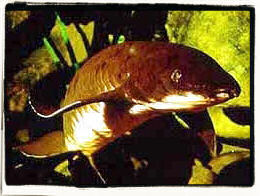 to the Gint. See: "Gint."
to the Gint. See: "Gint."
"Any of six species (three species according to some authorities) of air-breathing fishes placed with a number of extinct forms in the subclass Dipnoi (order Dipnoi of some authorities). The Dipnoi first appeared in the Lower Devonian Period (about 370,000,000–395,000,000 years ago). The extant species occur in rivers and lakes in Africa, South America, and Australia. They are especially interesting because of their characteristic body forms, their generally large size, their erratic distribution over the tropical regions of the earth, and their peculiar mode of life." — Encyclopaedia Britannica ©2006.
"It was similar to the tiny lung fish I had seen earlier on the river, those little creatures clinging to the half-submerged roots of shore trees, and, as often as not, sunning themselves on the backs of tharlarion, those tiny fish called gints." — Explorers of Gor, page 384.
Marine Saurians
Most probably, the large sea-tharlarion. Please refer to the Tharlarion page for further information. See also in the Reptile Section: "Marine Saurians."
Oysters
A shellfish of the Vosk delta.
of the Vosk delta.
"Any member of the families Ostreidae (true oysters) or Aviculidae (pearl oysters), bivalve mollusks found in temperate and warm coastal waters of all oceans. Bivalves known as thorny oysters (Spondylus) and saddle oysters (Anomia) are sometimes included in the group. True oysters have been cultivated as food since pre-Christian times. Pearl oysters also have long been valued for the precious pearls that develop in them.
Like other bivalves, most oysters are either male or female, although hermaphroditism also occurs. Ostrea edulis exhibits a phenomenon called rhythmical hermaphroditism, in which an individual alternates sexes seasonally or with changes in water temperature. Oysters breed in the summer. The eggs of some species are released into the water before fertilization by the sperm; the eggs of others are fertilized within the female. The young are released as ciliated spheres known collectively as spat, which swim for several days before attaching themselves permanently to a site. Edible oysters are ready for harvesting in three to five years.
True oysters (family Ostreidae) include species of Ostrea, Crassostrea, and Pycnodonte. Common Ostrea species include the European flat, or edible, oyster, O. edulis; the Olympia oyster, O. lurida; and O. frons. Crassostrea species include the Portuguese oyster, C. angulata; the North American, or Virginia, oyster, C. virginica; and the Japanese oyster, C. gigas. Pearl oysters (family Aviculidae) are mostly of the genus Meleagrina, sometimes called Pinctada or Margaritifera. O. edulis occurs from the coast of Norway to waters near Morocco, through the Mediterranean Sea, and into the Black Sea. It is hermaphroditic and attains lengths of about 8 cm (about 3 inches). O. lurida, of the Pacific coastal waters of North America, grows to about 7.5 cm (3 inches). C. virginica, native to the Gulf of Saint Lawrence to the West Indies and about 15 cm (6 inches) long, has been introduced into Pacific coastal waters of North America. Up to 50,000,000 eggs may be released by the female at one time. Commercially, C. virginica is the most important North American mollusk. C. angulata occurs in coastal waters of western Europe. C. gigas, of Japanese coastal waters, is among the largest oysters, attaining lengths of about 30 cm (1 foot). Like C. virginica, the Sydney rock oyster (Crassostrea commercialis) changes sex; born male, it changes to female later in life. It is the most economically important Australian edible oyster.
Pearls are formed in oysters by the accumulation of nacre, the material lining the oyster shell, around a solid piece of foreign matter that has become lodged inside the shell. Pearls formed in edible oysters are lustreless and of no value. The best natural pearls occur in a few Oriental species, particularly Meleagrina vulgaris, native to the Persian Gulf. This species is found mainly at depths of 8 to 20 fathoms (48 to 120 feet). Pearls are taken mostly from oysters more than five years old. Cultured pearls are grown around bits of mother-of-pearl inserted manually into the oyster. Most cultured pearls are grown in Japanese or Australian coastal waters. — Encyclopaedia Britannica ©2006.
"Other girls had prepared the repast, which for the war camp, was sumptuous indeed, containing even oysters from the delta of the Vosk." — Captive of Gor, — page 301.
Parsit
A migratory, silvery fish having brown stripes. Similar to Earth trout.
"… several varieties of migrating parsit, a small, narrow, usually striped fish. " — Beasts of Gor, page 38.
"The slender striped parsit fish has vast plankton banks north of the town, and may there, particularly in the spring and the fall, be taken in great numbers… Trade to the south, of course is largely in furs acquired from Torvaldsland, and in barrels of smoked, dried parsit fish." — Marauders of Gor, pages 27-28.
"Three other men of the Forkbeard attended to fishing, two with a net, sweeping it along the side of the serpent, for parsit fish, and the third, near the stem, with a hook and line, baited with vulo liver, for the white-bellied grunt, a large game fish which haunts the plankton banks to feed on parsit fish." — Marauders of Gor, page 59.
"The men with the net drew it up. In it, twisting and flopping, silverish, striped with brown, squirmed more than a stone of parsit fish. They threw the net to the planking and, with knives, began to slice the heads and tails from the fish." — Marauders of Gor, page 61.
Sea-Tharlarion
Aquatic version of the land beast. It seems there are both the large Sea Tharlarion as well as the smaller versions. Please refer to the Tharlarion page for further information.
"Now this," Saphrar the merchant was telling me, "is the braised liver of the blue, four-spired Cosian wingfish." This fish is a tiny, delicate fish, blue, about the size of a tarn disk when curled in one's hand; it has three or four slender spines in its dorsal fin, which are poisonous; it is capable of hurling itself from the water and, for brief distances, on its stiff pectoral fins, gliding through the air, usually to evade the smaller sea-tharlarions, which seem to be immune to the poison of the spines. — Nomads of Gor, page 84.
"It is called the wingfish because it can, on its stiff pectoral fins, for short distances, glide through the air, usually in an attempt to flee small sea tharlarion, who are immune to the poison of the spines." — Raiders of Gor, page 139.
Tamber Clam
This is a clam common in the Vosk river; the shells are polished and used for things such as jewelry.
clam common in the Vosk river; the shells are polished and used for things such as jewelry.
"They are probably false stones," I said, "amber droplets, the pearls of the Vosk sorp, the polished shell of the Tamber clam, glass colored and cut in Ar for trade with ignorant southern peoples." — Nomads of Gor, page 20.
Unnamed Fish
Tiny yellow fish are mentioned; no name give to the fish, however.
"I crawled in the direction of the brook, and, lying on my stomach before it, scooped water into my mouth. What I thought was a petaled flower underneath the swift, cold surface of the brook suddenly broke apart, becoming a school of tiny yellow fish." — Captive of Gor, page 36.
Vosk Carp
A fish native to the Vosk.
"I saw the sudden, rolling yellowish flash of the slatted belly of a water tharlarion, turning as it made its swift strike, probably a Vosk carp or marsh turtle." — Raiders of Gor, page 1.
Vosk Sorp
This is a giant oyster, common in the Vosk river; the pearls that the sorp produces are used to make headbands and other jewelry, and the giant shell used by Rencers as a throne.
"They are probably false stones," I said, "amber droplets, the pearls of the Vosk sorp, the polished shell of the Tamber clam, glass colored and cut in Ar for trade with ignorant southern peoples." — Nomads of Gor, page 20.
"He sat upon a giant shell of the Vosk sorp, as on a sort of throne, which, for these people, I gather it was." — Raiders of Gor, page 14.
"On his forehead there was tied a headband formed of the pearls of the Vosk sorp." — Raiders of Gor, page 18.
Whales
There are many types of whales on Gor. There are two categories: the baleen (rather than teeth, there are bony plates) and the (true) toothed whales. 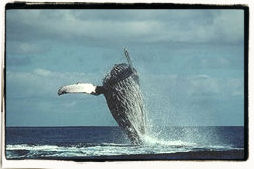 I have often seen on many sites the misconception that a baleen whale is one species of whale, when it is in actuality a physical genus. Please see: "Baleen Whale" for more information.
I have often seen on many sites the misconception that a baleen whale is one species of whale, when it is in actuality a physical genus. Please see: "Baleen Whale" for more information.
The Blunt Fin Whale is one of the varieties of baleen whales found on Gor.
"Two weeks ago, some ten to fifteen sleeps ago, by rare fortune, we had managed to harpoon a baleen whale, a bluish, white-spotted blunt fin." — Beasts of Gor, page 265.
The Hunjer Whale, black in color, is one of the toothed whales that lives in the arctic north; most likely the Orca of Gor.
"The red hunters lived as nomads, dependent on the migrations of various types of animals, in particular the northern tabuk and four varieties of sea sleen. Their fishing and hunting were seasonal, and depended on the animals. Sometimes they managed to secure the northern shark, sometimes even the toothed Hunjer whale or the less common Karl whale, which was a four-fluked, baleen whale." — Beasts of Gor, page 36.
"Suddenly, not more than a dozen feet from the boat, driving upward, rearing vertically, surging, expelling air in a great burst of noise, shedding icy water, in a tangle of lines and blood, burst the towering, cylindrical tonnage of the black Hunjer whale… The monster, as though it stood on its flukes, towered forty feet above us, the line like a tiny thread, billowing, leading downward to the boat… The Hunjer whale is a toothed whale." — Beasts of Gor, page 258.
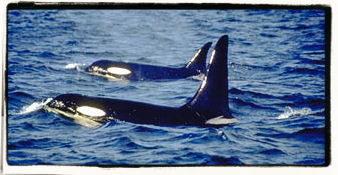 The Orcas of Earth are a toothed whale. The Sperm Whale of Earth is also a toothed whale.
The Orcas of Earth are a toothed whale. The Sperm Whale of Earth is also a toothed whale.
The Hunjer Long Whale is mentioned as being a rare whale.
"That scent, I knew, a distillation of a hundred flowers, nurtured like a priceless wine, was a secret guarded by the perfumers of Ar. It contained as well the separated oil of the Thentis needle tree; an extract from the glands of the Cartius river urt; and a preparation formed from a disease calculus scraped from the intestines of the rare Hunjer Long Whale, the result of the inadequate digestion of cuttlefish. Fortunately, too, this calculus is sometimes found free in the sea, expelled with feces. It took more than a year to distill, age, blend and bond the ingredients." — Marauders of Gor, page 114.
The 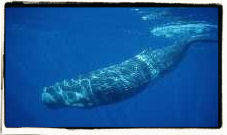 Karl Whale is one of the baleen-type whales that inhabit the arctic north; rare.
Karl Whale is one of the baleen-type whales that inhabit the arctic north; rare.
"The red hunters lived as nomads, dependent on the migrations of various types of animals, in particular the northern tabuk and four varieties of sea sleen. Their fishing and hunting were seasonal, and depended on the animals. Sometimes they managed to secure the northern shark, sometimes even the toothed Hunjer whale or the less common Karl whale, which was a four-fluked, baleen whale." — Beasts of Gor, page 36.
![]()
Special Note
Because of the differences in publishing the books, depending upon whether published in the U.S. or Europe, depending upon whether a first publishing or a Masquerade Books release, page numbers will often vary. All of my quotes are from original, first-printing U.S. publications (see The Books page for a listing of publishers and dates) with the exception of the following books:
- Tarnsman of Gor (2nd Printing, Balantine)
- Outlaw of Gor (11th Printing, Balantine)
- Priest-Kings of Gor (2nd Printing, Balantine)
- Assassin of Gor (10th Printing, Balantine)
- Raiders of Gor (15th Printing, Balantine)
- Captive of Gor (3rd Printing, Balantine)
Disclaimer
These pages are not written for any specific home, but rather as informational pages for those not able to get ahold of the books and read them yourself. Opinions and commentaries are strictly my own personal views, therefore, if you don't like what you are reading — then don't. The information in these pages is realistic to what is found within the books. Many sites have added information, assuming the existences of certain products and practices, such as willowbark and agrimony for healing, and travel to earth and back for the collection of goods. I've explored the books, the flora, the fauna, and the beasts, and have compiled from those mentioned, the probabilities of certain practices, and what vegetation mentioned in the books is suitable for healing purposes, as well as given practicalities to other sorts of roleplaying assumptions.